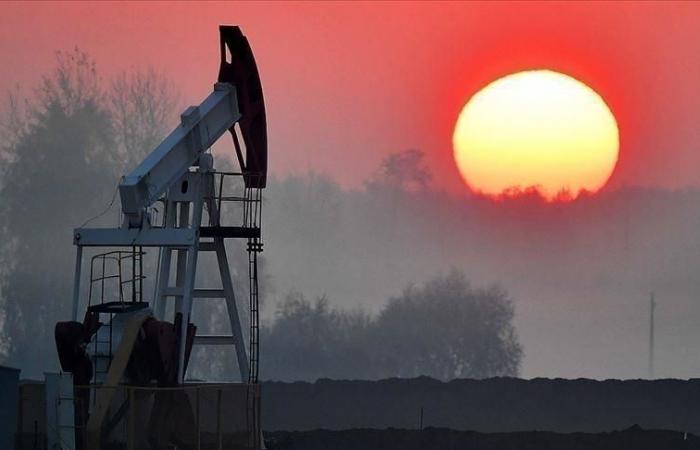An expected meeting of the “OPEC +” alliance next Thursday
The meeting will present its plan to reduce production for the month of January 2022
The United States wants a significant increase in production
– Mutant “Omicron” turned the cards on the “OPEC +” table
Attention is drawn to the upcoming ministerial meeting of the “OPEC +” alliance of oil producers, to be held on Thursday, during which the alliance is scheduled to respond to the decision to withdraw strategic reserves taken by major countries led by the United States in an attempt to reduce global crude prices.
The coalition, whose meeting was postponed by one day – which was scheduled for Wednesday – will also consider the future consequences of the new mutant of the Corona virus “Omicron”, without neglecting the warnings of “serious concerns” issued, Monday, by the World Health Organization.
At the head of the “OPEC +” alliance are Saudi Arabia (a close ally of Washington) and Russia (the traditional opponent of the United States), as Riyadh and Moscow faced a price war more than once, but today they are turning into allies in defense of their interests.
** the beginning
The year 2014 was pivotal in relations between Russia, Saudi Arabia and the United States, as the increase in shale oil production of the United States and other producers led to the collapse of crude prices from about $114 to less than $27 in 2016.
This tremor marked the beginning of an unofficial alliance between Saudi Arabia and Russia, which led to the establishment of the “OPEC +” group, which consists of the 13 members of the Organization of the Petroleum Exporting Countries (OPEC), led by Saudi Arabia, and 10 producers from outside it, led by Russia.
In November 2016, the countries affiliated with the coalition agreed on the first collective production cut, most of which was borne by Saudi Arabia (500,000 barrels per day) and Russia (230,000 barrels per day).
Since then, the alliance of Saudi Arabia and Russia within the framework of “OPEC +” has succeeded in maintaining the balance of global markets and the stability of crude prices at a level above $ 50 for most of the period from 2016-2020.
** Corona explodes the alliance
But the oil markets, and with them the Saudi-Russian alliance, faced a crisis of a new kind in 2020, represented by the “Corona” pandemic, which is the most dangerous pandemic in 100 years.
As global demand for crude fell sharply as most countries in the world rushed to impose restrictions on movement, including closing borders and airspace for months.
In the face of the new emergency, on March 5, 2020, Saudi Arabia proposed to its “OPEC +” allies to deepen production cuts to restore balance to the markets and raise prices, but the proposal was met with a Russian rejection, which opened the door to the harshest price war in the history of the industry.
** Saudi Arabia declares war
On March 7, 2020, just two days after the failure of the “OPEC +” meeting, Saudi Arabia announced a reduction in the official price for selling its crude oil by up to $8 a barrel, in a strategy aimed at achieving the largest possible drop in the price of oil and as soon as possible.
On March 10, the Russian Finance Minister replied that his country could withstand an oil price of $25-30 per barrel for the next six to ten years.
This statement prompted Saudi Arabia to respond by ordering Aramco to raise its supplies by a quarter to 12.3 million barrels per day, an increase of 2.6 million barrels per day over its production levels in the recent period.
The next day, the Ministry of Energy issued a new order for Aramco (the largest oil company in the world), to raise its production to a maximum capacity of 13 million barrels, and this was offset by Russia’s announcement that it could pump oil at higher rates as well.
** Black Tuesday
On Tuesday, April 21, 2020, it was a black day in the history of the oil industry, as the benchmark Brent crude price plunged to less than $16 a barrel, the lowest in 21 years, while US crude prices collapsed below zero for the first time in history, and reached Negative $40 a barrel.
** American mediation
The collapse of oil prices dealt a severe blow to the budgets of all producing countries, and their cash reserves began to erode, and the continuation of prices at this level is no longer possible, even by Saudi Arabia and Russia.
Meanwhile, the United States witnessed an unprecedented wave of bankruptcy for shale oil companies, with the high cost of extracting it.
The severe damage caused by the price war prompted former US President Donald Trump to mediate between Riyadh and Moscow, whose first sign of success was Saudi Arabia’s invitation to “OPEC +” countries to a meeting on April 9, 2020, with the participation of countries from outside, including the United States.
The call resulted in an agreement to reduce production by a record 9.7 million barrels per day, to be reduced gradually until April 2022.
** Improved demand
With the improvement in demand, starting from the second half of 2020, the “OPEC +” alliance accelerated the increase in crude pumping into global markets, but the pace of this increase in crude production did not keep pace with the global economic recovery from the Corona pandemic.
For months, the “OPEC + alliance” rejected the requests of major consumers, led by the United States and India, to pump more crude oil, at a time when energy prices increased from their pre-pandemic levels.
** Biden is in a political crisis
With the mid-term elections of the US Congress approaching, with both houses of Congress, and US President Joe Biden’s fear of losing a simple Democratic majority, under inflationary pressures, one of the main reasons for which is the rise in energy prices, Biden decided to act.
On Tuesday, November 23, the US President ordered the use of 50 million barrels of strategic reserves, amounting to about 600 million barrels, within a coordinated withdrawal from the reserves with India, Japan, Britain and South Korea.
However, the move did not succeed in reducing prices, but it was offset by a rise of more than 2.5 percent the next day.
However, Saudi Arabia and Russia began talks away from the limelight, to crystallize a response to the step of the United States and other countries to withdraw from the reserves, and this accelerated the emergence of the new strain of Corona, which led to a decrease in prices by more than 13 percent in one day, Friday.
Reports indicated that the new allies, Saudi Arabia and Russia, are heading to propose canceling an approved increase in production by 400,000 barrels per day until the end of next December, in an unprecedented challenge from Saudi Arabia to the US administration.
The news published on the official page of Anadolu Agency is an abbreviation for a part of the news that is presented to subscribers via the News Stream System (HAS). To subscribe to the agency, please contact the following link.
These were the details of the news Oil is changing alliances… Russia and Saudi Arabia versus the United... for this day. We hope that we have succeeded by giving you the full details and information. To follow all our news, you can subscribe to the alerts system or to one of our different systems to provide you with all that is new.
It is also worth noting that the original news has been published and is available at saudi24news and the editorial team at AlKhaleej Today has confirmed it and it has been modified, and it may have been completely transferred or quoted from it and you can read and follow this news from its main source.





